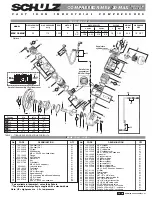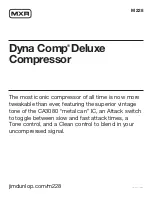
Portable Compressor 7/20
13---7
SEPTEMBER 2003
As dilute sulphuric acid is used as electrolyte, be careful not to
contaminate your eyes, hands, clothes, and metals with the
electrolyte. If it gets in your eye, wash with a large amount of water
at once, then seek medical advice.
As highly flammable hydrogen gas is released from the batteries,
do not create a spark or allow any naked flame near the batteries.
When handling such metallic articles as tools near the batteries,
be sure not to contact the “+” terminal because the compressor
body is “---” and a dangerous short circuit might result.
When disconnecting the terminals, start with “---” terminal. When
connecting them, connect the “---” terminal last.
13.5.4.
Checks And Operation After Start---Up
Checks During Operation
While running, make the following checks to see that all parts are
working correctly.
Radiator Cooling Water (Coolant)
WARNING
Do not remove radiator cap until coolant temperature is
well below its boiling point. Then loosen cap slightly to the
stop position, to relieve any pressure, before removing cap
completely.
When the engine overheats and hot coolant overflows through
the radiator and hoses, stop the engine immediately and make
the following checks to determine the cause of trouble:
Check Item
(1.) Check to see if there is any coolant leak,
(2.) Check to see if there is any obstacle around the cooling air
inlet or outlet,
(3.) Check to see if there is any dirt or dust between radiator fins
and tube,
(4.) Check to see if the fan belt is too loose,
(5.) Check to see if radiator water pipe is clogged,
(6.) Check to see if anti---freeze is mixed to a 50/50 % mix of
water and anti---freeze.
13.5.5.
Operation And Care Of A New Engine
Your Ingersoll---Rand engine is carefully tested and adjusted in
the factory, however, further run---in is necessary. Avoid any
harsh engine operation within the initial 100 operating hours.
Do not operate the unit at full load until the engine is warmed---up.
Do not allow the engine to run unloaded for extended periods so
as to minimise the risk of cylinder bore glazing.
During operation, pay attention to the following points if the
engine shows any sign of abnormalities.
(1.) Engine Oil Pressure
The engine oil pressure is monitored by a switch that will stop the
engine if the pressure falls below a pre---set value.
(2.) Coolant Temperature
The engine performance will be adversely affected if engine
coolant temperature is too hot or too cold. The normal coolant
temperature is 75÷85
˚
C (167÷185
˚
F).
Overheating
CAUTION
IF YOU SEE OR HEAR ESCAPING STEAM OR HAVE OTHER
REASON TO SUSPECT THERE IS A SERIOUS OVERHEAT
CONDITION, STOP THE ENGINE IMMEDIATELY.
If the engine coolant temperature gage (where fitted) shows an
overheat condition, or you have reason to suspect the engine
may be overheating, take the following step:
---
Close the service valve to reduce the load,
---
Let the engine run at normal idle speed for two or three
minute. If the engine coolant temperature does not
start to drop, turn off the engine and proceed as
follows:
CAUTION
DO NOT OPEN THE CANOPY IF YOU SEE OR HEAR STEAM
OR ENGINE COOLANT ESCAPING. WAIT UNTIL NO STEAM
OR ENGINE COOLANT CAN BE SEEN OR HEARD BEFORE
OPENING THE ENGINE CANOPY.
DO NOT REMOVE THE RADIATOR FILLER CAP IF THE
ENGINE COOLANT IN THE RESERVE TANK IS BOILING.
ALSO DO NOT REMOVE THE RADIATOR FILLER CAP WHILE
THE ENGINE AND RADIATOR ARE STILL HOT. SCALDING
FLUID AND STEAM CAN BE BLOWN OUT UNDER PRESSURE
IF EITHER CAP IS TAKEN OFF TOO SOON.
If no steam or engine coolant can be seen or heard, open the
canopy. If the engine coolant is boiling, wait until it stops before
proceeding. The engine coolant level should be between the
“MAX COLD” and “MIN” marks on the reserve tank.
Make sure the fan belt is not broken, or off the pulley, and that the
fan turns when the engine is started. If the engine coolant level
in the reserve tank is low, look for leaks at the radiator hoses and
connections, radiator, and water pump. If you find major leaks,
do not run the engine until these problems have been corrected.
If you do not find a leak or other problem, wait until the engine has
cooled down then carefully add engine coolant to the reserve
tank.
Engine coolant is a mixture of ethylene glycol antifreeze and
water. Refer to the
Table 13---5. OPERATION TEMPERATURE
of
this section for the proper antifreeze and mixture.
CAUTION
TO AVOID BEING BURNED, DO NOT SPILL ANTIFREEZE OR
ENGINE COOLANT ON THE EXHAUST SYSTEM OR HOT
ENGINE PARTS. UNDER SOME CONDITIONS THE
ETHYLENE GLYCOL IN ENGINE COOLANT IS
COMBUSTIBLE.
If the engine coolant level in the reserve tank is at the correct level
but there is still an indication of an overheat condition and no
cause was found, please consult your local Ingersoll---Rand
branch or dealer.
Overcooling
Operating the engine at low coolant temperature will not only
increase the oil and fuel consumption but also will lead to
premature parts wear which may result in engine failure. Ensure
that the engine reaches normal operating temperature 75÷85
˚
C
(167÷185
˚
F) within ten minutes of starting.
(3.) Hour meter
This meter indicates the machine operation hours. Make sure
that the meter is always working during engine operation.
Periodical machine maintenance is scheduled on the operation
hours indicated on the hourmeter.
(4.) Liquid And Exhaust Smoke Leakage
Make regular checks for lubricant, fuel, coolant and exhaust
smoke leakage.














































